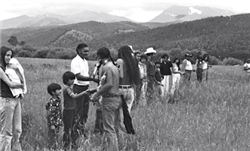Welcome to La Sierra
0
0

Welcome to La Sierra
History
Double click to edit text
Learn
"Local people believe that ultimately, no one owns La Sierra--the mountain owns us by claiming our spirits and giving us the opportunity to develop a sense of place..." (Peña)
The original Mexican land grant understood La Sierra as a commons to support the community. La Sierra was open for the collection of firewood, trapping, and grazing cattle.
With its high elevation and extreme weather, the Valley was not an easy place for Mexican settlers. La Sierra, and the common land rights that came with it, supported generations of Mexican and Chicano settlers in the Valley.
Continue

In 1981, La Sierra became the ignition point for what would be Colorado's longest lawsuit.
Jack Taylor, a North Carolina lumber mogul bought a section of La Sierra. Despite communal use of the land being legally connected to his purchase, Taylor put up barbed wire fences blocking access to La Sierra.
Once again, Chicano historic, legal, and cultural understandings of land and community were facing erasure.
The lawsuit was resolved in 2002. The verdict was that if you could prove ancestry from the original Mexican settlers, you would be allowed to use La Sierra.
On the surface that may seem like a victory.
However for many who I spoke with in the Valley, the verdict erases and others understanding of the land. The land was never meant for one group, it was meant to support any community member of the Valley.
Pictured: 1981, descendants of the Valley's chicano settlers join hands on the landscape in protest of of Taylor's actions.
At the eastern end of the Valley is a stretch of land called La Sierra.
The Valley was first settled under a Grant-Merced Land Grant in the 1840s. Under Spanish property law, the grant designated some 77,00 acres of the Valley for communal use. This was La Sierra.
In the 1860s when the Valley became part of the United States, the first forms of erasure began to Chicano legal rights, and cultural and communal understandings of the land.
After the Spanish American War, the San Luis Valley was added to the United States as a part of New Mexico. The Valley was then purchased by the state of Colorado, although the composition of the Valley (Chicano settlers) was different from many other areas being settled by Anglos.
The Valley experienced an influx of Anglo settlers coming to Colorado as part of the westward expansion movement and the homesteaders act.
Attracted by manifest destiny narratives, the new settlers of the region did not see the already established Chicano setters as rightful occupants of the land.
A series of often violent conflicts between Anglo and Chicano settler broke out over the following couple decades, with American law often taking the side of the Anglo settlers.
Where you look onto now is a part of La Sierra called Zapata ranch. It was the home and land of a Chicano rancher Teofilo Trujillo. Although he was also a homesteader, the Zapata ranch was burnt to the ground in 1902 by anglo cattlemen.
The land is now owned by the National Parks Service.
Continue